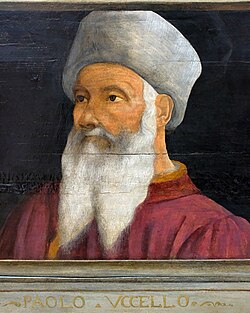Paolo Uccello | |
|---|---|
 Portrait of Paolo Uccello (unknown artist) Louvre Museum, Paris | |
| Born | Paolo di Dono 1397 |
| Died | 10 December 1475 (aged 77–78) Florence, Republic of Florence |
| Nationality | Italian |
| Education | Lorenzo Ghiberti |
| Known for | Painting, fresco |
| Notable work | Funerary Monument to Sir John Hawkwood, Saint George and the Dragon, The Battle of San Romano |
| Movement | Early Renaissance |
Paolo Uccello (/uːˈtʃɛloʊ/ oo-CHEL-oh, Italian: [ˈpaːolo utˈtʃɛllo]; 1397 – 10 December 1475), born Paolo di Dono, was an Italian Renaissance painter and mathematician from Florence who was notable for his pioneering work on visual perspective in art. In his book Lives of the Most Excellent Painters, Sculptors, and Architects, Giorgio Vasari wrote that Uccello was obsessed by his interest in perspective and would stay up all night in his study trying to grasp the exact vanishing point. Uccello used perspective to create a feeling of depth in his paintings. His best known works are the three paintings representing the battle of San Romano, which were wrongly entitled the Battle of Sant'Egidio of 1416 for a long period of time.[1]
Paolo worked in the Late Gothic tradition, emphasizing colour and pageantry rather than the classical realism that other artists were pioneering. His style is best described as idiosyncratic, and he left no school of followers. He has had some influence on twentieth-century art and literary criticism (e.g., in the Vies imaginaires by Marcel Schwob, Uccello le poil by Antonin Artaud and O Mundo Como Ideia by Bruno Tolentino).
- ^ Herbermann, Charles, ed. (1913). . Catholic Encyclopedia. New York: Robert Appleton Company.